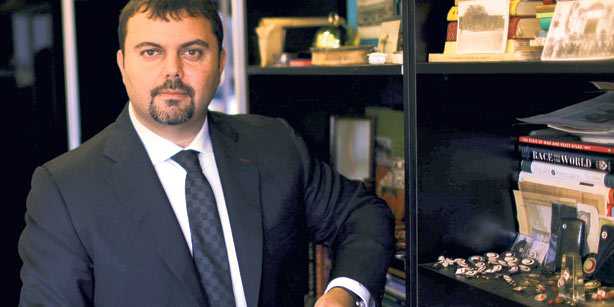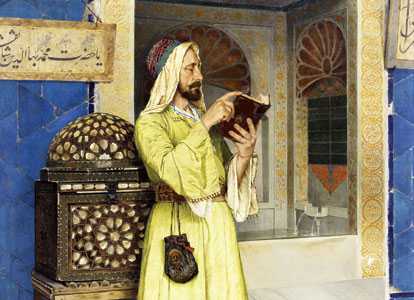30 October 2011, Sunday / FATİH VURAL , İSTANBUL

Orlando Carlo Calumeno
When we suggested coming by his home to view his collection in greater detail, Orlando Carlo Calumeno said: “Come to my office. You will find all your expectations fulfilled there.” I was doubtful, but when I saw the vast array of Ottoman memorabilia, medals and various ephemera in his office, I understood what he had been talking about. And when he took his huge collection of postcards out from a large cupboard and laid them out on the table, it was quite clear just how special it was.
Calumeno, who comes from a “Levantine” family that immigrated to Turkey from Italy, is 41 years old. He has been collecting Ottoman-era postcards now for the past 25 years, and has accumulated more than 15,000 of them by now. Of these, some 1,200-1,300 are photo cards, meaning there has been no editing to transform them into any special sort of postal card. They are simply photographs that have been turned into cards. The rest are all postcards that have been specially edited to make them suited for printing as postcards. In fact, many of these cards have Armenian, Ottoman Turkish and French writing on them, a reflection of the multilingualism of the Ottoman Empire in general.
Nearly 12,000 of these postcards have Anatolian images on them, while the remaining 3,000 bear imagery of İstanbul. Calumeno’s collection makes him the owner of the world’s largest such collection, something not claimed by himself, but which has been asserted by prestigious philately societies. In fact, there used to be a couple of collections which rivaled his in Europe, but those have subsequently been broken up.
Calumeno’s archive has also helped produce three books. In his book “Armenians in Turkey 100 Years Ago,” Calumeno uses his postcards to tell the story of Armenians in Anatolia and İstanbul. In another book, “İzmir in the Past,” Calumeno brings the history of İzmir to readers in the present. And in his book “Heirlooms Freedom” he gives readers a broad historical and societal panorama of 19th-century Turkish history. Each of these three books toured the world along with exhibitions. Calumeno loves to open his collection up for viewing, and explains: “Some collectors do not enjoy sharing their collections publicly. But my goal is to the contrary, I want to share with people that the Ottoman era between 1890 and 1919 was a very wonderful one, which is why my collection is open to use for everyone.” Some projects that appear on the horizon in connection with Calumeno’s collection are “Greeks in the Past,” “Ottoman Photographers in Anatolia,” some centennial celebrations of the Battle of Çannakale and the 100th anniversary of the Charter of Alliance (Sened-i İttifak).
Everything began with a blood feud in Perugia
Calumeno’s roots lie in Italy. His father is Italian, his mother Armenian. One part of his family, which used to live in Perugia 500 years ago, fled Italy because of blood feuds threatening them. In doing so, they moved to Dino Island, although some time later this Italian island fell under the control of the Greeks. At this point, Calumeno’s family came under Greek pressure to switch from Catholicism to Orthodoxy, which is when the family, refusing to do so, moved to İzmir in the 1700s. Once in İzmir, the Calumeno family established a store, specializing in “züccaciye,” or glassware, porcelain and similar house ware. After about 40 years in İzmir, they moved to İstanbul.
Calumeno’s grandfather once had a silver collection that boasted the stamps of various Ottoman pashas. As for his father, his interest was Ottoman porcelain and silver. It was with these inspirations before him, and hearing so much from his father about what the meanings were behind the various stamps on the porcelain, that Calumeno decided, when he was 16 or so, that he, too, wanted to collect something. He settled on postcards, explaining: “At that time, prices were very reasonable for postcards. I had a basic principle, which was that I was going to spend around 10 percent of my pocket money on my collection. The first postcard I bought was one showing Sultanahmet Square, at the turn of the 20th century…”
Interestingly enough, the writing on the back of this first postcard Calumeno bought touched upon a personal subject, his Armenian roots. When he first looked at the postcard, there was something written in a language he didn’t recognize. He asked his mother, who looked at it and was touched, saying, “My son, that is Armenian.” Calumeno said: “I can neither read nor write Armenian, but I can speak it, as it was spoken at home. My mother’s side of the family originates from İzmir and Trabzon.” He continues the story about the first postcard as follows: “When my mother read what was written on it, I understood. It was from a young woman, a new mother, living in İstanbul, writing to her sister living in Bursa, who had also just become a mother. She writes: ‘You are now also a mother. When you nurse, use the recipe for the pomade I wrote you about to prevent dryness and cracking.’ Of course, when I could understand the message on this old postcard, it made me even more interested.”
Calumeno began to try and collect more Ottoman postcards with Armenian on them at first, and then turned his focus to postcards bearing Anatolian imagery. Over time, 25 years to be precise, his collection swelled to include 15,000 such postcards.
These postcards now represent a fortune
“When I started to collect postcards, no one was really interested in them,” says Calumeno. “At that time, old İstanbul postcards were $5-10, and no one was interested in Anatolian postcards. Although people would pay high prices for İstanbul-marked postcards, they used to laugh at me for paying $30-40 per Anatolian postcard. But now these postcards have prices that range between $800-1,500 apiece,” Calumeno notes.
Calumeno says collections do not come about just as a result of money, but that people need time and patience to put together good collections. “Let’s say you have $1 million. But if you say that with it [$1 million] you are going to create this same collection, it is just not possible. It took me 25 years to collect all these postcards. There are some postcards I have seen only once in my lifetime, and those don’t even have prices attached to them!”
Calumeno sees himself not as the owner of these postcards, but more as their guardian. He says: “The real owner of all these [postcards] is Anatolia. They are from the various Armenians, Greeks, Jews, the French, the Germans and the Muslims of the various cities of Anatolia. They were all Ottoman subjects at the time when these postcards were printed, and then sent abroad. And now, after a century, we are bringing them back to these lands. They are returning to the place where they were born, Anatolia. I am just a temporary guardian of these Anatolian treasures.”
Postcards from İstanbul to NYC in just 15 days at turn of century
In order to be a good collector, you must have a good ear. Calumeno, who has friends in every city and in every country that keep an eye out for postcards for him, has postcards delivered to him from all over the world, from Argentina to Hong Kong. “For example, one evening, someone told me they had found some very rare Konya postcards in South Africa. We told them to immediately send us some images. That is why technology is so important. When you see the image, you can give the order to purchase, and have them in your office two days later. Fifty years ago, this couldn’t have happened that way,” says Calumeno.
Of course, there are some notable exceptions; Calumeno explains that he has seen postcards that went from İstanbul to New York in just 15 days, at the turn of the century!
Calumeno’s 9-year-old son is also now interested in collections, though he chooses to spend his pocket money on Fenerbahçe and Kadıköy area postcards. He, like his father, is a devoted Fenerbahçe fan. Actually, Calumeno’s fan status for Fenerbahçe goes beyond the ordinary. He is a member of the football club’s council, and his office is filled with uniforms and shoes that have been signed by many of the great players the team has had, from Lefter Küçükandonyadis to Can Bartu to Roberto Carlos to Alexsandro de Souza, or simply Alex.
The first postcard sold in İstanbul
There are some very unique postcards in Orlando Carlo Calumeno’s archive. He shows us a lithograph of an İstanbul panorama, and explains: “This is not a photograph. The image was engraved onto copper afterward. It was then pressed and colored. This was done in 1890-1895.”
Another special postcard he shows off is one bearing the signature of renowned postcard editor and photographer Max Fruchterman. “He had a painter create an image. He saw how it’s all supposed to look. They then engraved the image onto copper. When this was subsequently replaced with steel, the quality went down. When you stamp out 100 postcards from copper, after the 100th, the copper starts to degrade and the images become blurrier,” he says.
The handiwork involved in the images on these postcards is striking. The lithographs of the Galata Tower are very valuable, between TL 3,000-4,000 apiece, and they are so rare you cannot find them anymore. The first postcard that was sold in İstanbul is in Calumeno’s collection. It is also signed by Fruchterman, and dates from between 1875 and 1880. And actually, this postcard was sought after by someone writing the life story of the family of German photographer Fruchterman. When they finally learned about its existence, the price was of course, well, priceless.




